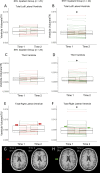Decreased Brain Ventricular Volume in Psychiatric Inpatients with Serotonin Reuptake Inhibitor Treatment
- PMID: 35859799
- PMCID: PMC9290100
- DOI: 10.1177/24705470221111092
Decreased Brain Ventricular Volume in Psychiatric Inpatients with Serotonin Reuptake Inhibitor Treatment
Abstract
Background: Brain ventricles have been reported to be enlarged in several neuropsychiatric disorders and in aging. Whether human cerebral ventricular volume can decrease over time with psychiatric treatment is not well-studied. The aim of this study was to examine whether inpatients taking serotonin reuptake inhibitors (SRI) exhibited reductions in cerebral ventricular volume.
Methods: Psychiatric inpatients, diagnosed mainly with depression, substance use, anxiety, and personality disorders, underwent two imaging sessions (Time 1 and Time 2, approximately 4 weeks apart). FreeSurfer was used to quantify volumetric features of the brain, and ANOVA was used to analyze ventricular volume differences between Time 1 and Time 2. Inpatients' brain ventricle volumes were normalized by dividing by estimated total intracranial volume (eTIV). Clinical features such as depression and anxiety levels were collected at Time 1, Time 1.5 (approximately 2 weeks apart), and Time 2.
Results: Inpatients consistently taking SRIs (SRI + , n = 44) showed statistically significant reductions of brain ventricular volumes particularly for their left and right lateral ventricular volumes. Reductions in their third ventricular volume were close to significance (p = .068). The inpatients that did not take SRIs (SRI-, n = 25) showed no statistically significant changes in brain ventricular volumes. The SRI + group also exhibited similar brain structural features to the healthy control group based on the 90% confidence interval comparsions on brain ventricular volume parameters, whereas the SRI- group still exhibited relatively enlarged brain ventricular volumes after treatment.
Conclusions: SRI treatment was associated with decreased brain ventricle volume over treatment.
Keywords: MRI; SNRI; SSRI; brain ventricles; brain volumetry; neuroimaging biomarkers; serotonin reuptake inhibitors; ventriculomegaly.
© The Author(s) 2022.
Conflict of interest statement
Declaration of Conflicting Interests: The author(s) declared no potential conflicts of interest with respect to the research, authorship, and/or publication of this article.
Figures

References
Grants and funding
LinkOut - more resources
Full Text Sources

